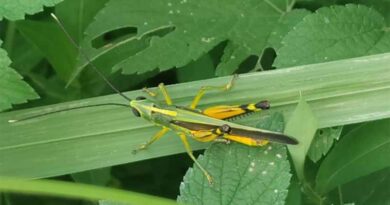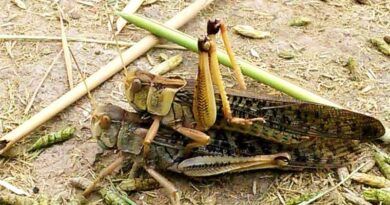Ovarian development of yellow-spined bamboo locust sheds light on emergence and migratory nature of pest
16 March 2023, Laos: Scientists from the Chinese MARA-CABI Joint Laboratory for Biosafety have created a model which can estimate adult emergence periods and identify migratory populations of the yellow-spined bamboo locust from their ovarian development.
Outlined in a new study published in the journal Frontiers in Physiology, the researchers say their model provides a quick way of to determine the population source as either “native” or “immigrant” from the phenotypic traits without dissection.
Research on the ovarian development of insect pests helps provide key information for predicting pest occurrences, and currently, there is very limited information about the reproductive system of the yellow-spined bamboo locust (Ceracris kiangsu Tsai).
The yellow-spined bamboo locust can devour all bamboo leaves in its path and is the main pest of China’s bamboo-producing regions. The country accounts of about one-fourth of the global production of bamboo worth around USD$ 28.32 billion a year.
In July 2020, for instance, the pest was found to have infested the city of Pu’er in China’s southwestern Yunnan province originated from neighbouring Laos and Vietnam. The pest also infested 13 districts in the three northern provinces of Phongsali, Luangprabang and Huaphan, in Laos.
The study aimed to assess the reproductive fitness of 321 adult female insects by using traditional methods to dissect female adults, measure female ovaries, and assess the process of egg formation.
Phenotypic traits including body weight and body length were also measured and used to estimate the model of ovarian developmental stages.
The monitoring and prediction of insect pests is fundamental to conducting effective pest management and current measures include light traps, sex pheromone traps and field monitoring.
Another technique that has been used to predict pest population dynamics and occurrences in migrating species is the dissection of adult female insects.
This method has been shown to provide information on not only the ovarian development but also the peak oviposition period, which can then be used to estimate the reproductive capacity of the population and migration potential of the pest.
Dr Hongmei Li, a lead author of the research and Senior Coordinator for Research at CABI in China, said, “Despite much research on insect ovarian development, relatively little is known about the reproduction system development of the yellow-spined bamboo locust.
“This study aimed to investigate the potential of using ovarian development monitoring in order to predict the reproduction ability and the population dynamics of C. kiangsu.
“Ovarian development significantly influences the reproduction and expansion capabilities of insect pest populations, and it should be considered when developing sustainable pest management strategies, especially for migratory species.”
The scientists added that by grading the ovarian development stages of the yellow-spined bamboo locust, it is easier to identify the transition and critical time between different stages – therefore improving the prediction accuracy of the population development of the pest.
Dr Homgmei Li added, “This study also provides additional information about further exploration of C. kiangsu reproduction systems.”
Also Read: Tendovo soybean herbicide from Syngenta earns rave reviews during first season of use
(For Latest Agriculture News & Updates, follow Krishak Jagat on Google News)















